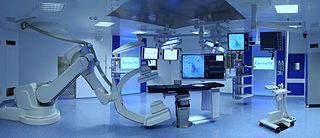Related Research Articles

Neurosurgery or neurological surgery, known in common parlance as brain surgery, is the medical specialty concerned with the surgical treatment of disorders which affect any portion of the nervous system including the brain, spinal cord and peripheral nervous system.
Lars Leksell (1907–1986) was a Swedish physician and Professor of Neurosurgery at the Karolinska Institute in Stockholm, Sweden. He was the inventor of radiosurgery.

Minimally invasive procedures encompass surgical techniques that limit the size of incisions needed, thereby reducing wound healing time, associated pain, and risk of infection. Surgery by definition is invasive and many operations requiring incisions of some size are referred to as open surgery. Incisions made during open surgery can sometimes leave large wounds that may be painful and take a long time to heal. Advancements in medical technologies have enabled the development and regular use of minimally invasive procedures. For example, endovascular aneurysm repair, a minimally invasive surgery, has become the most common method of repairing abdominal aortic aneurysms in the US as of 2003. The procedure involves much smaller incisions than the corresponding open surgery procedure of open aortic surgery.
Image-guided surgery (IGS) is any surgical procedure where the surgeon uses tracked surgical instruments in conjunction with preoperative or intraoperative images in order to directly or indirectly guide the procedure. Image guided surgery systems use cameras, ultrasonic, electromagnetic or a combination or fields to capture and relay the patient's anatomy and the surgeon's precise movements in relation to the patient, to computer monitors in the operating room or to augmented reality headsets. This is generally performed in real-time though there may be delays of seconds or minutes depending on the modality and application.
The study of neurology and neurosurgery dates back to prehistoric times, but the academic disciplines did not begin until the 16th century. From an observational science they developed a systematic way of approaching the nervous system and possible interventions in neurological disease.
William Howard Feindel was a Canadian neurosurgeon, scientist and professor.

Robot-assisted surgery or robotic surgery are any types of surgical procedures that are performed using robotic systems. Robotically assisted surgery was developed to try to overcome the limitations of pre-existing minimally-invasive surgical procedures and to enhance the capabilities of surgeons performing open surgery.

Interventional magnetic resonance imaging, also Interventional MRI or IMRI, is the use of magnetic resonance imaging (MRI) to do interventional radiology procedures.
Neuronavigation is the set of computer-assisted technologies used by neurosurgeons to guide or "navigate” within the confines of the skull or vertebral column during surgery, and used by psychiatrists to accurately target rTMS. The set of hardware for these purposes is referred to as a neuronavigator.
Computer-assisted surgery (CAS) represents a surgical concept and set of methods, that use computer technology for surgical planning, and for guiding or performing surgical interventions. CAS is also known as computer-aided surgery, computer-assisted intervention, image-guided surgery, digital surgery and surgical navigation, but these are terms that are more or less synonymous with CAS. CAS has been a leading factor in the development of robotic surgery.
Ablative brain surgery is the surgical ablation by various methods of brain tissue to treat neurological or psychological disorders. The word "Ablation" stems from the Latin word Ablatus meaning "carried away". In most cases, however, ablative brain surgery does not involve removing brain tissue, but rather destroying tissue and leaving it in place. The lesions it causes are irreversible. There are some target nuclei for ablative surgery and deep brain stimulation. Those nuclei are the motor thalamus, the globus pallidus, and the subthalamic nucleus.
IMRIS founded in 2005, IMRIS is a global provider of intraoperative imaging solutions.

A hybrid operating room is a surgical theatre that is equipped with advanced medical imaging devices such as fixed C-Arms, X-ray computed tomography (CT) scanners or magnetic resonance imaging (MRI) scanners. These imaging devices enable minimally-invasive surgery. Minimally-invasive surgery is intended to be less traumatic for the patient and minimize incisions on the patient and perform surgery procedure through one or several small cuts.
Albert Loren Rhoton Jr., was an American neurosurgeon and a professor specializing in microsurgical neuroanatomy. He developed and introduced a number of microsurgical techniques that improved the safety and effectiveness of neurosurgery, including the use of the surgical microscope in neurosurgery. He also designed many of the commonly used of microneurosurgical instruments, which bear his name. Such tools in use worldwide include the Rhoton Micro Dissectors designed for delicate work in the treatment of brain aneurysms and tumor resection.

Aaron A. Cohen-Gadol is a professor of neurological surgery in the department of neurosurgery at Indiana University School of Medicine and a neurosurgeon at Indiana University Health specializing in the surgical treatment of complex brain tumors, vascular malformations, cavernous malformations, etc. He performs removal of brain tumors via minimally invasive endoscopic techniques, which use the nasal pathways instead of opening the skull.
Intraoperative magnetic resonance imaging (iMRI) refers to an operating room configuration that enables surgeons to image the patient via an MRI scanner while the patient is undergoing surgery, particularly brain surgery. iMRI reduces the risk of damaging critical parts of the brain and helps confirm that the surgery was successful or if additional resection is needed before the patient’s head is closed and the surgery completed.

Mazor Robotics was an Israeli medical device company and manufacturer of a robotic guidance system for spine surgery that was acquired by Medtronic in December 2018. Surgeons that utilized Mazor Robotics Renaissance generally specialize in orthopedic surgery or neurosurgery.

James Rutka is a Canadian neurosurgeon from Toronto, Canada. Rutka served as RS McLaughlin Professor and Chair of the Department of Surgery in the Faculty of Medicine at the University of Toronto from 2011 – 2022. He subspecializes in pediatric neurosurgery at The Hospital for Sick Children (SickKids), and is a Senior Scientist in the Research Institute at SickKids. His main clinical interests include the neurosurgical treatment of children with brain tumours and epilepsy. His research interests lie in the molecular biology of human brain tumours – specifically in the determination of the mechanisms by which brain tumours grow and invade. He is the Director of the Arthur and Sonia Labatt Brain Tumour Research Centre at SickKids, and Editor-in-Chief of the Journal of Neurosurgery.

Ferenc Andras Jolesz was a Hungarian-American physician and scientist best known for his research on image guided therapy, the process by which information derived from diagnostic imaging is used to improve the localization and targeting of diseased tissue to monitor and control treatment during surgical and interventional procedures. He pioneered the field of Magnetic Resonance Imaging-guided interventions and introduced of a variety of new medical procedures based on novel combinations of imaging and therapy delivery.

Claire Karekezi is a Neurosurgeon at the Rwanda Military Hospital in Kigali, Rwanda. As the first woman neurosurgeon in Rwanda, and one of six neurosurgeons serving a population of 13 million, Karekezi serves as an advocate for women in neurosurgery. She has become an inspiration for young people pursuing neurosurgery, particularly young women.
References
- ↑ Pandya, Shawna; Motkoski, Jason W.; Serrano-Almeida, Cesar; Greer, Alexander D.; Latour, Isabelle; Sutherland, Garnette R. (1 December 2009). "Advancing neurosurgery with image-guided robotics". Journal of Neurosurgery. 111 (6): 1141–1149. doi:10.3171/2009.2.JNS081334. PMID 19374495.
- ↑ "IMRIS SYMBIS Homepage". Archived from the original on 2013-01-10.
- ↑ "Canadian robot does better brain surgery". USA Today. 2007-04-17. Retrieved 2011-05-04.
- ↑ Jackson, Brian (2008-04-02). "Canadian robot set to perform brain surgery". IT Business. Retrieved 2011-05-04.
- ↑ "Robot set to revolutionize brain surgery". CTV. 2007-04-17. Retrieved 2011-05-04.
- ↑ "neuroArm - World's first image-guided surgical robot to enhance accuracy and safety of brain surgery". University of Calgary. Archived from the original on 2019-05-02. Retrieved 2011-05-03.
- ↑ Dawn, Walton (2007-04-17). "As a matter of fact, it IS rocket science". Globe and Mail. Retrieved 2011-05-04.
- ↑ "neuroArm : revolutionary procedure a world first". Archived from the original on 2019-05-02. Retrieved 2017-09-06.. www.ucalgary.ca (16 May 2008). Retrieved 14 November 2012.